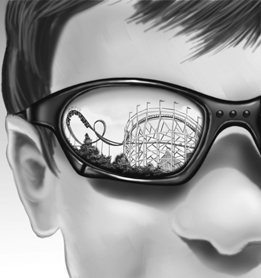Lesson 5
1. Lesson 5
1.9. Connect
Module 4: Quadratic Equations and Inequalities
Open your copy of the Lesson 5 Assignment, which you saved in your course folder at the start of this lesson. Complete the assignment.
![]() Save your work in your course folder.
Save your work in your course folder.

liquidlibrary/Thinkstock
The Cannon Coaster at Coney Island was an early twentieth-century rollercoaster designed to leap across a gap in the tracks. Unfortunately, the ride failed initial safety tests because factors, such as uneven weight distribution and prevailing wind conditions, would often cause crashes. As a result, the gap was closed and the ride lost a measure of its thrill. Despite this, many people lined up to experience the ride due to false rumours that lives were lost in the ride’s construction.
Project Connection
Go to Module 4 Project: Imagineering. Complete Step 3: Design and Construction.
![]() Save your work in your course folder.
Save your work in your course folder.
Going Beyond

The experiment demonstrated in Gravity Experiment (“Newton's Laws: Summary”) is a classic physics problem that shows that the horizontal component of an object’s motion is independent of its vertical component. You don’t have to take this explanation at face value though. Try this experiment to see if it is true. You will need to work with a partner.
Problem
If two objects fall from the same height, will the objects hit the ground at the same time even if one object possesses a horizontal velocity?
Materials
- two small objects of similar size and weight (e.g., tennis balls, toy cars, whiteboard brushes)
- a flat elevated surface that is at least 1 m in length (e.g., table top, whiteboard ledge)
Procedure
For the purpose of this procedure, assume that the objects are tennis balls and that the flat surface is a kitchen table.
Step 1: Hold Ball A at the level of the flat surface in preparation to drop the ball to the floor.
Step 2: Have your partner position himself or herself at the other end of the table with Ball B.
Step 3: Your partner rolls the ball towards the edge of the table with enough force that it will fall off the table.
Step 4: At the moment Ball B rolls off the edge of the table, drop Ball A.
Step 5: Observe how the balls land—Ball A first, Ball B first, or both balls at the same time.
Step 6: Repeat steps 1 to 5, but have your partner roll Ball B at different speeds.
Analysis
- How did the balls land?
- How did changing the speed of the rolling ball affect the results?
- What conditions are necessary in order for the results of this experiment to be repeated?
- What implications do the results have for calculating how long it takes an object to land?
![]() You may want to save your answers in your course folder.
You may want to save your answers in your course folder.
If you plan to study physics, this might be a problem that you will encounter again.
